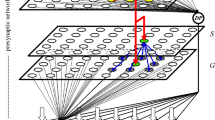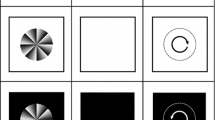Abstract
Motion perception is one of the most important aspects of the biological visual system, from which people get a lot of information of the natural world. In this paper, trying to simulate the neurons in MT (motion area in visual cortex) which respond selectively both in direction and speed, the authors propose a novel multiplicative inhibitory velocity detector (MIVD) model, whose spatiotemporal joint parameterK determines its optimal velocity. Based on the Response Amplitude Disparity (RAD) property of MIVD, two multi-velocity fusion neural networks (a simple one and an active one) are built to detect the velocity of 1-Dimension motion. The experiments show that the active MIVD Neural Network with a feedback fusion method has a relatively better result.
Similar content being viewed by others
References
Enroth-Cugell C, Robson J G. The contrast sensitivity of retinal ganglion cells of the cat.J. Physiol. (Lond.), 1966, 187: 517–552.
Marr D. Vision: A Computational Investigation into the Human Representing and Processing of Visual Information. San Francisco: W.H. Freeman, 1982.
Ullman S. The Interpretation of Visual Motion. MIT Press, Cambridge, MA, 1979.
Movshon J A, Adelson E H, Gizzi M S, Newsom W T. The analysis of moving visual patterns. InPattern Recognition Mechanisms, Changas C, Gattass R, Gross C (eds.), pp.117–151, Exp. Brain Research Supplement 11, 1985.
Hubel D H, Wiesel T N. Receptive Fields and Functional Architecture in Two Nonstriate Visual Areas (18 and 19) of the Cat.J. Neurophysiol, 1965, 128: 229–289.
Hubel D H, Wiesel T N. Functional Architecture of Macaque Monkey Visual Cortex. InProc. R. Soc. Lond. Ser. B 1997, 198: 1–59.
Organ G A. Velocity tuned cortical cells and human velocity discrimination.Brain Mechanisms of Spatial Vision, Ingle D J, Jeannerod M, Lee D N (eds.), Martinus Nijhof, La Haye, The Netherlands, 1984.
Koenderink J J, van Doorn A J, van de Grind W A. Spatial and temporal parameters of motion detection in the peripheral visual field.J. Optical Society of America, 1985, 2: 252–259.
Reichardt W. Autocorrelation, a principle for the evaluation of sensory information by the central nervous system. InSensory Communication, Rosenblith W A (ed.), Wiley, New York, 1961.
Bouzerdoum A, Pinter R B. Nonlinear Lateral Inhibition Applied to Motion Detection in the Fly Visual System. InNonlinear Vision: Determination of Neural Receptive Fields, Function, and Networks, Pinter R B, Bahram Nabet (eds.), 1991, pp.423–450.
Barlow H B, Levick R W. The mechanism of directional selectivity in the rabbit’s retina.J. Physiol. (Lond.), 1965, 173: 477–504.
Reichardt W, Poggio T, Hausen K. Figure-ground discrimination in the visual system of the fly. II towards the neural circuitry.Biol Cybern. (Suppl.), 1983, 46: 1–30.
Pinter R B. Adaptation of receptive field spatial organization via multiplicative lateral inhibition.J. Theor. Biol., 1984, 110: 435–444.
Bouzerdoum A, Pinter R B. Modeling the Processing and Perception of Visual Motion.Sensory Neural Networks: Lateral Inhibition, Nabet B, Pinter R B (eds.), CRC Press, Boca Roton, FL, 1991, pp.47–68.
Pinter R B. The electrophysiological bases for linear and for nonlinear product term lateral inhibition and the consequences for wide field textured stimuli.J. Theor. Biol., 1983, 105: 233–243.
Author information
Authors and Affiliations
Corresponding author
Additional information
This research is partially supported by the Trans-Century Talents Foundation of the State Education Commission of China and the National Foundation for Outstanding Youth in Natural Science.
Wang Aiqun received the B.Sc degree and the Ph.D. degree both in electric and control engineering from the Xi’an Jiaotong University in 1992 and 1997, respectively. Her study fields include computer vision, image processing, signal processing, especially the early vision modeling. Besides participating several projects relative to computer vision and image processing, she also published several papers in this field.
Zheng Nanning received the M.Sc degree in information and control engineering from Xi’an Jiaotong University and the Ph.D in electric and computer science from Keio University of Japan in 1981 and 1985, respectively. From 1986 to 1990, he was an Associate Professor, Institute of Artificial Intelligence and Robotics, Xi’an Jiaotong University, China. Since 1990 he has been a Professor of the Institute of Institute of Artificial Intelligence and Robotics, Xi’an Jiaotong University, where he is currently the Director of the Institute of AI & Robotics.
His major current research interests include pattern recognition, computer vision and neural networks.
Rights and permissions
About this article
Cite this article
Wang, A., Zheng, N. Multiplicative inhibitory velocity detector and multi-velocity motion detection neural network model. J. of Comput. Sci. & Technol. 13, 41–54 (1998). https://doi.org/10.1007/BF02946613
Received:
Revised:
Issue Date:
DOI: https://doi.org/10.1007/BF02946613




